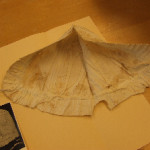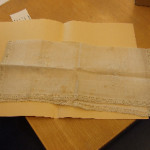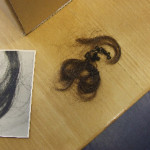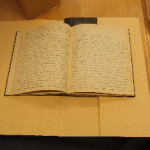[:nl]Dorothea (Dora) Visser (Gendringen, Gelderland, 28 september 1819 – Olburgen, Gelderland, 11 juli 1876) was een Nederlandse rooms-katholieke mystica en zieneres, die de kruiswonden van Christus aan haar lichaam droeg.
Dora Visser werd geboren in een arme dagloners familie te Gendringen in een katholiek deel van de Achterhoek, ze was de middelste van negen kinderen. Op 12-jarige leeftijd moest ze in betrekking op een boerderij. Bij het weiden van de koeien ontstond na een val een open wond die niet genas. Het meisje werd mank en kon in het vervolg alleen nog licht zittend werk doen. De jonge Dora was een vrome katholiek en offerde haar persoonlijk lijden op voor de bekering van zondaars uit liefde voor Jezus Christus. Zij ontving vanaf december 1843 de stigmata van Christus aan haar lichaam.
Haar geestelijk leidsmannen en biechtvaders, aanvankelijk kapelaan Herfkens en later kapelaan Teus Kerkhof, documenteerden het verborgen lijden en leven van Dora Visser nauwkeurig in dagboeken.
Dorothea Visser werd echter in de streek pers en door roddels aangevallen, maar er waren ook goede verdedigers, zoals haar huisdokter Te Welscher. Ernstiger was, dat Kerkhof naar de smaak van de pastoor van Gendringen een veel te prominente positie in de parochie innam – prominenter dan de pastoor zelf wellicht? Het conflict werd opgelost, maar wellicht speelde het nog mee toen de aartsbisschop van Utrecht Joannes Zwijsen kapelaan Kerkhof in 1861 overplaatste naar Zieuwent in dezelfde Achterhoek en later zelfs naar Kloosterburen, een afgelegen katholieke exclave in de provincie Groningen.
Teus Kerkhof werd daar pastoor en nam de zwakke Dora Visser mee als zijn huishoudster en sacristiehulp.In Kloosterburen treden dezelfde mystieke verschijnselen bij de zwijgzame Dorothea Visser op. In 1872 wordt Kerkhof tot pastoor van de parochie H. Willibrordus te Olburgen benoemd. Op 12 juli 1876 overleed Dora Visser, gestigmatiseerde mystica, in de pastorie van Olburgen en werd op het plaatselijke kerkhof begraven.
Pastoor Kerkhof merkte in zijn aantekeningen op dat zij op dat moment bijna drieëndertig jaar de kruiswonden op haar lichaam gedragen had, het aantal levensjaren van Jezus Christus op aarde. Kerkhof wilde over Dora publiceren, maar dit lag te gevoelig. In 1853 was het omstreden herstel van de bisschoppelijke hiërarchie in Nederland tot stand gekomen. Dit gaf een gespannen relatie met de protestanten en de golf van antipapisme die toen over Nederland spoelde, was ten tijde van Dora’s dood nog niet uitgewerkt. Zo kwam het dat de aandacht voor Dora verflauwde na haar dood. Er bleef echter zowel in Gendringen (onder de katholieken) als in Olburgen en omgeving (zowel onder katholieken als onder protestanten) een mondelinge traditie over Dora bestaan, en ook devotie bij individuele personen. Maar niet in het openbaar. Pas door publicaties van de journalist B. Kerkhoffs in 1965 in dagblad De Gelderlander over de nagelaten aantekeningen van pastoor Kerkhof kwam er hernieuwde belangstelling voor de mystica.
In 1991 was er te Doesburg een tentoonstelling over het leven van Visser. De devotie tot Dorothea Visser speelt zich nu grotendeels in de stilte van persoonlijk gebed af. Bij haar graf te Olburgen komen geregeld priesters en lekengelovigen samen om te bidden en zich door Dora’s stil gedragen lijden te laten inspireren tot navolging van het evangelie. In de zomer van 2008 werd bekend dat mogelijk een zaligverklaring van Visser nabij is. Het aartsbisdom Utrecht erkent namelijk de getuigenis van ten minste één wonderbaarlijke genezing op haar voorspraak.[:en]
Dorothea (Dora) Visser (Gendringen, Gelderland, 28 September 1819 – Olburgen, Gelderland, 11 July 1876) was a Dutch, Roman Catholic mystic and visionary, who bore the crucifixion wounds of Christ (stigmata) on her body.
Dora Visser was born into a poor working class family in a catholic area of the Achterhoek, the fifth of nine children. At the age of twelve she went to work on a farm. After a fall while grazing the cattle she got an open wound that would not heal. She became crippled and from then on could only do light work that could be done seated. The young Dora was a devout Catholic and, out of love for Jesus Christ, offered her personal suffering up for the conversion of sinners. Since December 1843 she received the stigmata on her body.
Her spiritual directors and confessors, initially the curate Father Herfkens and later the curate Father Teus Kerkhof, documented very carefully in journals the life and hidden suffering of Dora Visser.
Dorothea Visser was plagued by rumour and in the local press. However she also knew support from, for example, her physician Dr te Welscher. More serious was the fact that Fr Kerkhof had, in the eyes of the parish priest of Gendringen, a far too prominent place in the parish: perhaps even more prominent than that of the parish priest himself? The conflict was resolved, but may have still been of influence in the transferral in 1861 by the then Archbishop of Utrecht, Johannes Zwijsen, of the curate Father Kerkhof to Zieuwent, also in the Achterhoek, and later even as far as Kloosterburen, a remote enclave in the far northern province Groningen.
Teus Kerkhof became the Parish Priest there, and took the weak Dora Visser with him as housekeeper and sacristan. In Kloosterburen the same mysterious phenomena appeared in the reticent Dora Visser. In 1872 Father Kerkhof was appointed Parish Priest of the Saint Willibrord Parish in Olburgen. On 12 July 1876 the stigmatised mystic Dora Visser died in the presbytery at Olburgen and was buried in the parish cemetery.
Father Kerkhof mentioned in his notes that at that time she had carried the crucifixion wounds of Christ for nearly 33 years, the same as the lifespan of Jesus on earth. He wanted to publish the story of Dora, but at the time this was too sensitive a topic. In 1853 the controversial restoration of the Episcopal hierarchy in the Netherlands took place, which led to a tense relationship with the Protestant Churches, and the gulf of anti-papism in the Netherlands had not yet settled by the time of Dora’s death. Therefore the interest in Dora Visser faded after her death. However, an oral tradition around Dora remained among the Catholics in Gendringen and both Catholics and Protestants in Olburgen and the surrounding area, as well as a covert devotion among certain individuals. Only when the reporter B. Kerkhoffs wrote about the journals of Father Kerkhof in the daily newspaper “The Gelderlander” in 1965, was there renewed interest in this mystic.
In 1991 there was an exhibition in Doesburg about the life of Visser. The devotion to Dora Visser occurs now for the most part in the silence of personal prayer. Priests and lay faithful come regularly to her grave in Olburgen to pray and to be inspired by her quiet suffering to follow the Way of the Gospel. In the summer of 2008 the possibility of a beatification of Dora Visser came a step closer. For then the Archdiocese of Utrecht recognised the account of at least one miraculous healing at her intercession.[:]



